These men with jealousies in their hearts, concocted the real story of Guru Sahib sheltering the rebellious Khusro, Jahangeer’s son, who had fled a battle with his father and was a fugitive, to rouse the rage of Emperor Jahangeer which added fuel to the blazing fire. Along with these circumstances, Guru Sahib’s increasing influence on large numbers of Hindus and Muslims to adopt Gurmat, created a stir in the minds of the Brahmin Pandits (Hindu priests) and the Qazis (Muslim priests). The compilation of Sri Aad Granth jee (the early version of Sri Guru Granth Sahib Jee) was considered a serious blow to the monopolies and social oppression maintained by so-called men of religion. Through all these circumstances Guru Arjan Sahib Jee fell a victim to the bigotry and inhumanity of Jahangeer.
In “Tuzuk-i-Jahagiri” (“Memoirs of Jahangeer”), Jahangeer wrote:
“In Gobindwal, which is on the river Biyah (Beas), there was a Hindu named Arjun, in the garments of sainthood and sanctity, so much so that he had captured many of the simple-hearted of the Hindus, and even of the ignorant and foolish followers of Islam, by his ways and manners, and they had loudly sounded the drum of his holiness. They called him Guru, and from all sides stupid people crowded to worship and manifest complete faith in him. For three or four generations (of spiritual successors) they had kept this shop warm. Many times it occurred to me to put a stop to this vain affair or to bring him into the assembly of the people of Islam.
At last when Khusro passed along this road this insignificant fellow proposed to wait upon him. Khusro happened to halt at the place where he was, and he came out and did homage to him. He behaved to Khusro in certain special ways, and made on his forehead a finger-mark in saffron, which the Indians (Hindus) call qashqa (Tilak) and is considered propitious. When this came to my ears and I clearly understood his folly, I ordered them to produce him and handed over his houses, dwelling-places, and children to Murtaza Khan, and having confiscated his property commanded that he should be put to death.”
Chandu, the officer of Jahangeer, was in charge of torturing Guru Sahib. Guru Sahib told them, “I bear no enemies or ill-will against any one. All happens as God Almighty wills it to happen. I am prepared to accept His Will. You may do what you like”.
Day 1 of Torture: Chandu began to torture the Guru. On the first day, Guru Jee was not given anything to eat or drink. He was kept awake and not allowed to sleep at night. During the day his body was left in the full exposure of the burning heat of the sun. Guru Sahib bore all this calmly. He remained immersed in Simran and repeated from his lips, “WaaheGuroo, WaaheGuroo, WaaheGuroo…” and sang Shabads from Gurbaani.
Day 2 of Torture: On the following day, Chandu made the Guru sit in a large copper vessel. He filled the vessel with water. He ordered his men to light a fire under the copper vessel. The water began to get hot. After a time, the water began to boil. It scalded Guru Sahib’s body. But Guru Jee sat calmly and quietly. He showed no feeling of pain, nor did he cry out or even sigh. He felt no anger against those who were torturing him. He remained absorbed in the sweet remembrance of Waheguru and repeated, “All is happening, O Waheguru, according to Thy Will. Thy Will is ever sweet to me.” The boiling water made the Guru’s flesh soft and left blisters all over his body.
Day 3 of Torture: On the third day, Chandu ordered his men, “Make some sand red hot in iron pans. Seat the Guru in burning water. Then pour the red hot sand over his head and body”. The water boiled Guru Sahib’s flesh from below. The burning red-hot sand burned Guru Jee’s head and body from above. The persons engaged in torturing him were wet with sweat. They felt most uncomfortable because of the heat. It was the hottest summer month. But Guru Sahib kept calm and quiet. Again, Guru Jee felt no pain, nor did he cry out, sigh or feel anger. He kept thinking of Waheguru and doing Simran. Guru Jee repeated:
ਤੇਰਾ ਕੀਆ ਮੀਠਾ ਲਾਗੈ ॥teraa kee-aa meethaa laagai.
O Waheguru! Your actions seem so sweet to me.ਹਰਿ ਨਾਮੁ ਪਦਾਰਥੁ ਨਾਨਕੁ ਮਾਂਗੈ ॥੨॥੪੨॥੯੩॥har naam padaarath naanak maaNgai. ||2||42||93||
Nanak begs for the treasure of the Naam, the Name of the Lord. ||2||42||93||
Baba Mian Meer Jee (a Muslim Sufi Saint and friend of Guru Sahib) tried to intercede on behalf of Guru Sahib but Guru Jee forbid him to interfere in the “Will of the Almighty”. Guru Sahib said, “All is happening in accordance with Waheguru’s Will. Men who stand for Truth have often to suffer. Their sufferings give strength to the cause of Truth. Go, brother. Pray for me. Pray for the success of my cause. Pray for Victory to Truth.”
Day 4 of Torture: On the fourth day, Guru Jee was made to sit on an iron plate. It was heated from below. The iron plate became red hot with the heat. Guru Jee’s flesh began to be roasted. Burning red-hot sand was poured on his body. Guru Sahib sat calm and quite, without a cry or sigh, feeling no physical pain. He sat with his mind fixed on Waheguru and physically living the message of Gurbaani and accepting the Will of Waheguru sweetly.
Day 5 of Torture: On the fifth day, Guru Sahib was taken to the bank of the River Raavi bounded in shackles. Guru Sahib’s physical body was covered with burns and blisters. Guru jee was pelted with rocks. One rock hit Guru jee on his forehead which led to bleeding. Two drops of blood fell to the ground. Jahangeer had given strict orders that Guru jee should be tortured to death in a such a way that his blood should not fall on the ground in the belief that a holy or great man’s blood spilling on the ground leads to further martyrs being born. This tradition was called Nasar law and was upheld by Genghis Khan. To hide the bloodied body of Guru jee, the soldiers threw Guru jee’s body in the River Raavi and then concocted a story that Guru jee went to bathe and never came out of the river. This fake story was used to firstly, make the martyrdom into a suicide case and ensure that people do not revolt in response to the barbaric martyrdom of Guru jee.
Guru Arjan Dev Jee sowed the seeds of martyrdom which flourished after him and became the heritage of the Sikh People. Guru Sahib physically manifested and lived the Divine message of Gurbaani of conquering death and suffering, remaining fearless in defending the Truth, and showing the extremes one can take in remaining steadfast in the love of Waheguru and Guru Nanak Jee’s Sikhi. Guru Arjan Dev Jee said, lived, and showed that he can accept Shaheedi (martyrdom) but he cannot accept insult. The way a leader or prophet lives becomes the character of the followers. Guru Sahib showed that a Sikh should live in dignity and die with honour, and that a Sikh should never tolerate insult or oppression.
Dhan Satguru Sri Guru Arjan Dev Jee.
Shaheedaa Nu Lakh Lakh Parnaam.
Related Audios:
Dharmik Geet: Saara Hee Lahore Kambiaa
(Manmohan Waris/ Ghar Hunt Kitni Ku Door)
Shabad: Teraa Kee-aa Meethaa Laagai
(Gurbinder Kaur/ Southall Monthly Keertan
Editor’s Note: Some historical accounts state that Guru Sahib went to the river Ravi for ishnan and did not return at his own will, thereby refuting the claim that he was thrown into the river. For additional details, please see comments by Sukhdeep Singh under this post.

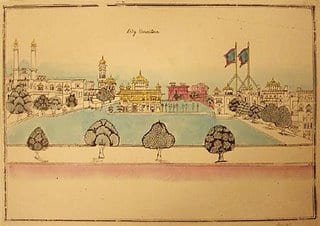
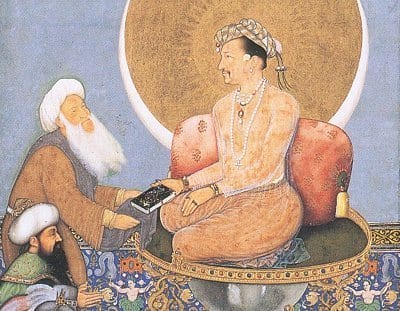
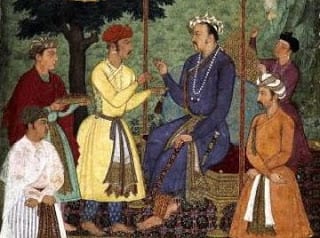

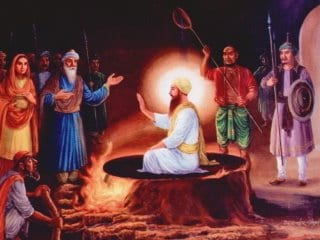
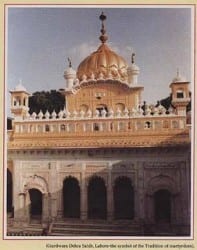
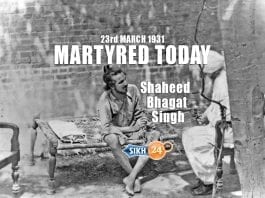


According to the historical counts I have read Sri Guru Ji was not thrown in the river. One account said he bathed and as he dipped in the river he did not return while another account ( Gurbilas 6) mentions how Sri Guru Ji was accompanied with 5 Gursikhs as he bathed in the ravi river he recited bani ( Sri Japji, Sukhmani Sahib). Sri Guru Ji then gave Hukum that after his joti jot then the Gursikhs should according to Maryada recite Sri Japji Sahib then placed his body in the river. THis is the account I like to remember of Sri Guru Arjan Dev Jis last days. The thought of SRi Guru Ji being thrown in the well does not settle well with me.
Also, nobody can torture Sri Guru JI. The only people who were torured where the manmukhs who try to torture SRi Guru Ji. While they were placing hot sand on Sri Guru Jis body Sri Guru Jis body remained cool while their bodies were burning inside. Torture means to inflict pain on another person . Sri Guru Ji is beyound pleasure and pain. The hot plate ( Tatta Tavi) became Tanda Tavi when Sri GUru Ji sat on the tavi. This is also mentioned in Gurbailas and Bhai Sahib Bhai Randhir SIngh JI.
Nice and informative artcile, but I disagre with the following quote.
“To hide the bloodied body of Guru jee, the soldiers threw Guru jee’s body in the River Raavi and then concocted a story that Guru jee went to bathe and never came out of the river. ”
Sri Guru Jis body was never thrown in the river; instead as part of his daily routine he bathed in the river during Amrit Vela. After reciting Sri Japji Sahib he did not return. This is according to Sikh history.